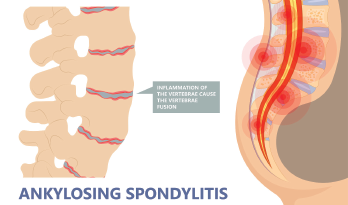
rumruay / shutterstock.com
ACR CONVERGENCE 2020—In recent years, a pathophysiological role for the interleukin (IL) 17/IL-23 axis in the development of psoriasis, enthesitis and inflammatory arthritis has been investigated in both rodent and human models. Clinical trials have demonstrated differential benefits for skin disease and joint disease in patients with psoriatic arthritis, axial spondyloarthritis (axSpA) and ankylosing spondylitis (AS).
During the session IL-17, IL-23 and Other Cytokine Targets: Lessons from Clinical Trials for Spondyloarthritis, two investigators reviewed the recent literature and shared emerging insights regarding cytokine-targeting therapies for various disease manifestations in spondyloarthritis.
Christopher Ritchlin, MD, MPH, professor and chief of the Division of Allergy, Immunology and Rheumatology, University of Rochester Medical Center, New York, discussed the genetic basis for susceptibility to the development of spondyloarthritis and shared insights from current research on the clinical benefits of blocking the IL-17/23 axis to treat patients with psoriatic arthritis.
Joerg Ermann, MD, an instructor in medicine at Harvard Medical School, Boston, and a researcher and rheumatologist at Brigham and Women’s Hospital, Boston, discussed the development and current trajectory for cytokine-targeting therapies used to treat axSpA.
Cytokine Targets in Psoriatic Arthritis

Dr. Ritchlin
Dr. Ritchlin, a principal investigator for several clinical trials testing the efficacy of agents in the treatment of psoriatic and rheumatoid arthritis and AS, explained that the IL-17/IL-23 axis has both IL-17-dependent and IL-17-independent pathways. In the IL-17-dependent pathway, IL-23 released by dendritic cells can activate the differentiation of T helper 17 (Th-17) cells through retinoid-related orphan receptor γt, releasing a variety of important cytokines, including IL-17A and IL-17F, as well as IL-22, that can influence a number of other cell types.
In the IL-17-independent pathway, IL-23 interacts with its receptor on a variety of cells. These interactions can promote a number of critical events in these cells, including angiogenesis, recruitment of cells and infiltration of activated Th-17 cells. Dr. Ritchlin noted, “These pathways really make a difference, particularly when you are looking at therapeutics.”
It’s important to recognize that IL-17 has a number of isoforms, Dr. Ritchlin stated. These isoforms include a homodimer (IL-17A) and a heterodimer (IL-17F) that bind to specific receptors. Receptor engagement results in downstream activation of P38, and subsequent transcription of NF-κB and activator protein 1 (AP-1) activation. These transcription factors promote the production of a variety of pro- and anti-inflammatory molecules. He also emphasized that Th-17 cells can be proinflammatory, anti-inflammatory or regulatory, and the micro-environment they are found in can help drive a cell in a certain direction, “so just seeing that a cell expresses the signature of an IL-17 helper cell does not necessarily tell you the function of that cell.”
In a brief review of the genetic basis of psoriatic arthritis from the perspective of IL-23, Dr. Ritchlin shared work by Stuart et al. comparing genetic SNPs of patients with psoriatic arthritis.1 He highlighted the potential associations of genetic snips with abnormalities in the IL-17/IL-23 axis.
Mouse Models
Looking at mouse models to understand the IL-17/IL-23 pathway and its relation to psoriatic arthritis, Dr. Ritchlin briefly discussed work by Sherlock et al. that demonstrated IL-23 could drive an enthesitis phenotype that may be mediated by a T cell that can stimulate osteoproliferation, inflammation and bone loss.2
He noted several other studies found different results. For example, in a mouse model using collagen-induced arthritis and given the IL-17 DNA minicircle, the mouse model developed psoriasiform lesions, synovitis and bone changes with evidence of myelopoiesis.3 In comparison, in a diabetic mouse model given IL-23 DNA in an adenovirus, the mice developed psoriasiform lesions, but also developed degenerative intervertebral disc disease, synovitis and cartilage loss.4
“These models are very important [in] telling us how IL-23 might drive various pathways in cell populations; however, directly translating [these findings] to human disease is fraught with problems,” Dr. Ritchlin stressed.
Another way IL-23 studies in mice might help reveal pathophysiology and biology is by looking at the effects of manipulating the environment in an IL-23 knockout, as discussed by Hamilton et al.5 These investigators examined lymphocyte-independent pain dependent on granulocyte macrophage-colony stimulating factor (GM-CSF), tumor necrosis factor and C-C class chemokines 17 (CCL17) by injecting zymosan into a mouse’s hind leg and measuring pain by the time the mouse bears no weight on the affected leg. They found significant pain reduction in the IL-23 knockout. “Here is an example of how a mouse model using knockouts can help you to focus on specific cells, cytokines and pathways that may be relevant for human disease,” Dr. Ritchlin said.
Clinical Benefits of Blockade Therapies
Next, Dr. Ritchlin talked about the contribution of the IL-17/IL-23 disease axis to the pathogenesis and clinical benefits of blockade in psoriatic arthritis. “We know that psoriatic arthritis is characterized by inflammation in a variety of different tissues. It’s also important to note that the IL-17/IL-23 pathway plays a role in each of these tissues, although it might be quite different, and we are just beginning to understand how that might be operative.”
The presence of a specific combination of cytokines in diseased tissue does not necessarily predict disease phenotype.
For example, Dr. Ritchlin discussed a study evaluating the transcriptomics in the skin and joints of patients with psoriatic arthritis, which found the predominant transcriptomic signature in the skin was IL-17, whereas in the joints it was tumor necrosis factor.6
“So we need to better understand the cell populations and environmental events that are occurring in target tissues, such as the skin, joint and entheses. With the arrival of precision-based medicine, single-cell RNA-seq and the ability to study the topography of tissues, we will have a much better idea of what’s happening in individual tissues and really be able to change how we approach [treatment for] individual patients,” he said.
Looking at the effects of certain blockade therapies for psoriatic arthritis, Dr. Ritchlin described findings from the EXCEED trial, comparing secukinumab and adalimumab at 52 weeks in biologic-naive psoriatic arthritis patients.7 “This important head-to-head study did not show a significant difference, although they came close, with secukinumab showing to be more efficacious for musculoskeletal domains for combined ACR50 and PASI [Psoriasis Area and Severity Index] 100 response and skin domain outcomes, while the safety profile did not favor secukinumab,” he said.
Several head-to-head studies were recently completed in patients with psoriatic arthritis, including a comparison of upadacitinib, a new Janus kinase inhibitor (jakinib), with placebo and adalimumab, which demonstrated resolution of enthesitis and dactylitis at week 24, with similar response rates noted between upadacitinib and adalimumab.8
Dr. Ritchlin then shared information regarding several agents in the pipeline, including bimekizumab, filgotinib and three other agents still in trials.8,9 He also mentioned forthcoming studies on different approaches to improve psoriatic arthritis, including dietary interventions, agents that alter the microbiome and combination biologics.
Cytokine-Targeting Therapies in AxSpA
Dr. Ermann began with a brief history of cytokine-blocking therapies for axSpA, starting with the first report of tumor necrosis factor inhibition in AS 20 years ago.
As of now, five different tumor necrosis factor inhibitors have been approved for the treatment of axSpA, and they have been recently joined by two inhibitors of IL-17A. Both modalities are now established treatments for patients with axSpA and AS. “Nevertheless, there are a number of open questions,” Dr. Ermann said.
“Among these, does biologic therapy inhibit radiographic progression? We still don’t have a conclusive answer for this question, and along those lines,” he asked, “are there differences between tumor necrosis factor and IL-17A inhibitors in that regard? Are there patient subsets with a priori preferential response to tumor necrosis factor versus IL-17A inhibition? Also, can drug-free remission be achieved and what are predictive biomarkers of response?”
Current Research

Dr. Ermann
Dr. Ermann went on to share current research that answers some of these questions. For example, two clinical studies evaluating secukinumab and ixekizumab demonstrated measurable benefit in AS patients who previously failed to respond to tumor necrosis factor inhibitors.10,11
“We currently do not have clinical trial evidence that patients who failed IL-17A inhibition therapy respond to tumor necrosis factor inhibition therapy. The question is, are there real subsets of patients who preferentially respond to one treatment or the other, and what is the underlying mechanism of that?”
Looking at the evidence to understand if axSpA patients can achieve drug-free remission, he shared findings from a 2005 study of infliximab that showed invariable relapse when patients with longstanding AS discontinued the TNF inhibitor.12
However, more recent studies show a less straightforward picture in patients with axSpA, Dr. Ermann said. For example, a 2018 drug-withdrawal trial of adalimumab in non-radiographic axSpA patients showed almost 50% of patients randomized to placebo remained in remission at one year.13
In a 2020 study of certolizumab for axSpA patients, the relapse curve looked different, with the patients randomized to placebo losing their response much quicker, but about one-fifth of patients appeared to remain in long-term, stable remission.14
“The interpretation of this still is open,” said Dr. Ermann, “and we need more data to have a conclusive answer to whether we can get patients into drug-free remission.”
Precise nomenclature is becoming increasingly important when discussing the role of IL-17/IL-23 in axSpA, he suggested. IL-17 is a family of six related cytokines (A-F) with structural similarities but different functions. The most closely related members of this family are IL-17A and IL-17F, which form homodimers or heterodimers all binding to the same receptor. Therapeutic monoclonal antibodies blocking these mediators have, to some degree, slightly different target specificities, and this may have an impact on efficacy or side effect profiles.
He also noted that the other IL-17 family members (B–E) differ substantially from IL-17A and IL-17F with regard to regulation and function. Their role in axSpA is largely unknown.
Regarding the therapeutic potential of blocking the IL-23 pathway in spondyloarthritis, he emphasized that the cellular interactions involved in the IL-17/IL-23 axis are complex. Contrary to expectations, IL-23 inhibitors failed in patients with axSpA and AS in two randomized controlled trials: a 2013 study and a 2019 study evaluating the IL-12/IL-23 inhibitor ustekinumab against placebo. Neither investigation showed signal in patients with AS.15,16
To explore why these IL-23 inhibitors failed in axSpA and AS, Dr. Ermann discussed six possible explanations, including two explanations he thinks are more plausible. The first possibility is that IL-23 plays a role during initiation of disease, but is not critical during established spinal disease. It is possible at that point that alternative signals drive secretion of IL-17A and other downstream mediators at axial sites at that time, he noted, and discussed research supporting these explanations.
For example, a 2018 study by van Tok et al. in a rat spondyloarthritis model demonstrated that if an antibody-mediated IL-23 blockade was started prior to disease onset, the animals were protected from developing arthritis; however, if initiation of IL-23 blockade was delayed until after disease development, no measurable therapeutic benefit occurred.17
A spatial component to the argument about the lack of efficacy of IL-23 inhibition could also exist, as outlined by Gracey et al., Dr. Ermann said.18 “It is well known that axSpA is strongly associated with inflammation in the gut; the relationship between spinal and intestinal inflammation could be causal, where subclinical inflammation in the gut is upstream, driving inflammation in the axial skeleton; or correlative with the alternative explanation that gut inflammation and inflammation in the axial skeleton are independent.” Intestinal inflammation during the initiation of disease (according to the causal model) might be responsive to IL-23 inhibition while inflammation in the axial skeleton is not, he speculated.
Dr. Ermann then discussed recent data on IL-23 inhibition in axial psoriatic arthritis. A subset analysis of two large clinical trials of guselkumab in PsA demonstrated that patients with imaging-confirmed sacroiliitis had significant improvement in the Bath Ankylosing Spondylitis Disease Activity Index (BASDAI), Ankylosing Spondylitis Disease Activity Score (ASDAS) and spinal pain. He cautioned that these findings, although interesting, are from a secondary analysis and should not be overinterpreted.19
Janus Kinase Inhibitors
Shifting to a discussion of alternative means to inhibit cytokine signals, Dr. Ermann discussed promising clinical trial results in AS with jakinibs, including tofacitinib, upadacitinib and filgotinib. These studies indicate clear benefits from jakinibs, including the improvement of inflammation in the sacroiliac joints as shown by magnetic resonance imaging.20
Dr. Ermann asked why jakinibs work in axSpA and AS, noting, “this is really an open question.”
Blockade of tumor necrosis factor and IL-17A is beneficial in axSpA and AS. Both of these cytokines engage signaling pathways that do not involve the Janus kinase signal transducer and activator of transcription. On the other hand, IL-6 and IL-23 where inhibitors are not beneficial in axSpA and AS, actually signal through Janus kinase pathways, he said. “Something is missing in the picture. I would predict there is an alternate critical cytokine that is expressed in the inflamed axial sites that could be targeted with biologics and that should then result in therapeutic benefit, but what this cytokine—or cytokines—may be is currently unclear.”
Carina Stanton is a freelance science journalist based in Denver.
References
- Stuart PE, Nair RP, Tsoi LC, et al. Genome-wide association analysis of psoriatic arthritis and cutaneous psoriasis reveals differences in their genetic architecture. Am J Hum Genet. 2015 Dec 3;97(6):816–836.
- Sherlock JP, Joyce-Shaikh B, Turner SP, et al. IL-23 induces spondyloarthropathy by acting on ROR-γt+ CD3+CD4-CD8- entheseal resident T cells. Nat Med. 2012 Jul 1;18(7):1069–1076.
- Adamopoulos IE, Suzuki E, Chao CC, et al. IL-17A gene transfer induces bone loss and epidermal hyperplasia associated with psoriatic arthritis. Ann Rheum Dis. 2015 Jun;74(6):1284–1292.
- Flores RR, Carbo L, Kim E, et al. Adenoviral gene transfer of a single-chain IL-23 induces psoriatic arthritis-like symptoms in NOD mice. FASEB J. 2019 Aug;33(8):9505–9515.
- Hamilton JA. GM-CSF in inflammation. J Exp Med. 2020 Jan 6;217(1):e20190945.
- Belasco J, Louie JS, Gulati N, et al. Comparative genomic profiling of synovium versus skin lesions in psoriatic arthritis. Arthritis Rheumatol. 2015 Apr; 67(4):934-944.
- McInnes, I, Behrens F, Mease PJ, et al. Secukinumab versus adalimumab for treatment of active psoriatic arthritis (EXCEED): A double-blind, parallel-group, randomized, active-controlled, phase 3b trial. Lancet. 2020 9;395 (10235):1496–1505.
- Ritchlin CT, Kavanaugh A, Merola JF, et al. Bimekizumab in patients with active psoriatic arthritis: Results from a 48-week, randomised, double-blind, placebo-controlled, dose-ranging phase 2b trial. Lancet. 2020 Feb 8;395(10222):427–440.
- Mease P, Coates LC, Helliwell PS, et al. Efficacy and safety of filgotinib, a selective Janus kinase 1 inhibitor, in patients with active psoriatic arthritis (EQUATOR): Results from a randomised, placebo-controlled, phase 2 trial. Lancet. 2018 Dec 1;392(10162):2367–2377.
- Sieper J, Deodhar A, Marzo-Ortega H, et al. Secukinumab efficacy in anti-TNF-naive and anti-TNF-experienced subjects with active ankylosing spondylitis: Results from the MEASURE 2 Study. Ann Rheum Dis. 2017 Mar;76(3):571–592.
- Deodhar A, Poddubnyy D, Pacheco-Tena C, et al. Efficacy and safety of ixekizumab in the treatment of radiographic axial spondyloarthritis: Sixteen-week results from a phase III randomized, double-blind, placebo-controlled trial in patients with prior inadequate response to or intolerance of tumor necrosis factor inhibitors. Arthritis Rheumatol. 2019 Apr;71(4):599–611.
- Baraliakos X, Listing J, Brandt J, et al. Clinical response to discontinuation of anti-TNF therapy in patients with ankylosing spondylitis after 3 years of continuous treatment with infliximab. Arthritis Res Ther. 2005;7(3):R439–444.
- Landewé R, Sieper J, Mease P, et al. Efficacy and safety of continuing versus withdrawing adalimumab therapy in maintaining remission in patients with non-radiographic axial spondyloarthritis (ABILITY-3): A multicentre, randomised, double-blind study. Lancet. 2018 Jul 14;392(10142):134–144.
- Landewé RB, van der Heijde D, Dougados M, et al. Maintenance of clinical remission in early axial spondyloarthritis following certolizumab pegol dose reduction. Ann Rheum Dis. 2020 Jul;79(7):920–928.
- Baeten D, Østergaard M, Wei JC, et al. Risankizumab, an IL-23 inhibitor, for ankylosing spondylitis: Results of a randomised, double-blind, placebo-controlled, proof-of-concept, dose-finding phase 2 study. Ann Rheum Dis. 2018 Sep;77(9):1295-1302.
- Deodhar A, Gensler LS, Sieper J, et al. Three multicenter, randomized, double-blind, placebo-controlled studies evaluating the efficacy and safety of ustekinumab in axial spondyloarthritis. Arthritis Rheumatol. 2019 Feb;71(2):258–270.
- van Tok MN, Na S, Lao CR, et al. The initiation, but not the persistence, of experimental spondyloarthritis is dependent on interleukin-23 signaling. Front Immunol. 2018 Jul 9;9:1550.
- Gracey E, Vereecke L, McGovern D, et al. Revisiting the gut-joint axis: Links between gut inflammation and spondyloarthritis. Nat Rev Rheumatol. 2020 Aug;16(8):415–433.
- Mease P, Helliwell P, Gladman D, et al. Efficacy of guselkumab, a monoclonal antibody that specifically binds to the p19 subunit of IL-23, on axial-related endpoints in patients with active PsA with imaging-confirmed sacroiliitis: Week-52 results from two phase 3, randomized, double-blind, placebo-controlled studies [abstract]. Arthritis Rheumatol. 2020;72(suppl 10).
- van der Heijde D, Deodhar A, Wei JC, et al. Tofacitinib in patients with ankylosing spondylitis: A phase II, 16-week, randomised, placebo-controlled, dose-ranging study. Ann Rheum Dis. 2017 Aug;76(8):1340–1347.
Last edited Sept. 8, 2021


